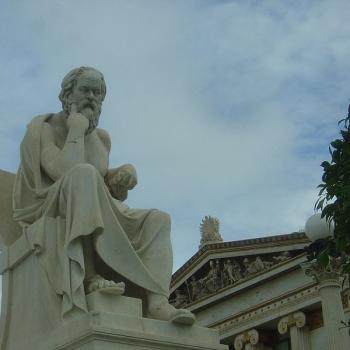
Atheist and anti-theist Bob Seidensticker, who was “raised Presbyterian”, runs the influential Cross Examined blog. He asked me there, on 8-11-18: “I’ve got 1000+ posts here attacking your worldview. You just going to let that stand? Or could you present a helpful new perspective that I’ve ignored on one or two of those posts?” He also made a general statement on 6-22-17: “Christians’ arguments are easy to refute . . . I’ve heard the good stuff, and it’s not very good.” He added in the combox: “If I’ve misunderstood the Christian position or Christian arguments, point that out. Show me where I’ve mischaracterized them.”
Such confusion would indeed be predictable, seeing that Bob himself admitted (2-13-16): “My study of the Bible has been haphazard, and I jump around based on whatever I’m researching at the moment.” I’m always one to oblige people’s wishes if I am able, so I decided to do a series of posts in reply. It’s also been said, “be careful what you wish for.” If Bob responds to this post, and makes me aware of it, his reply will be added to the end along with my counter-reply. If you don’t see that, rest assured that he either hasn’t replied, or didn’t inform me that he did. But don’t hold your breath.
Bob (for the record) virtually begged and pleaded with me to dialogue with him in May 2018, via email. But by 10-3-18, following massive, childish name-calling attacks against me, encouraged by Bob on his blog (just prior to his banning me from it), his opinion was as follows: “Dave Armstrong . . . made it clear that a thoughtful intellectual conversation wasn’t his goal. . . . [I] have no interest in what he’s writing about.”
And on 10-25-18, utterly oblivious to the ludicrous irony of his making the statement, Bob wrote in a combox on his blog: “The problem, it seems to me, is when someone gets these clues, like you, but ignores them. I suppose the act of ignoring could be deliberate or just out of apathy, but someone who’s not a little bit driven to investigate cognitive dissonance will just stay a Christian, fat ‘n sassy and ignorant.” Again, Bob mocks some Christian in his combox on 10-27-18: “You can’t explain it to us, you can’t defend it, you can’t even defend it to yourself. Defend your position or shut up about it. It’s clear you have nothing.” And again on the same day: “If you can’t answer the question, man up and say so.” And on 10-26-18: “you refuse to defend it, after being asked over and over again.” And again: “You’re the one playing games, equivocating, and being unable to answer the challenges.”
Bob’s cowardly hypocrisy knows no bounds. Again, on 6-30-19, he was chiding someone who (very much like he himself) was (to hear him tell it) not backing up his position: “Spoken like a true weasel trying to run away from a previous argument. You know, you could just say, ‘Let me retract my previous statement of X’ or something like that.” Yeah, Bob could! He still hasn’t yet uttered one peep in reply to — now — 40 of my critiques of his atrocious reasoning. As of 7-9-19, this is how Bob absurdly rationalizes his non-response: “He’s written several blog posts titled, in effect, ‘In Which Bob Seidensticker Was Mean to Me.’ Normally, I’d enjoy a semi-thoughtful debate, but I’m sure they weren’t.”
Bible-Basher Bob’s words will be in blue. To find these posts, follow this link: “Seidensticker Folly #” or see all of them linked under his own section on my Atheism page.
*****
Bob’s article, “5 Ways the Design Argument Fails” (8-21-20), takes on aspects of the classic theistic proof, the teleological argument, in one of its present guises, as argued by advocates of intelligent design. I shall examine some of his inadequately thought-through premises.
Does life on earth look designed by an intelligence? Science says no, and evolution explains why.
First of all, science, as presently defined and self-understood, cannot state one way or another whether God (assuming His existence for the sake of argument) designed anything or not, since its subject and object of study is matter, and God (again by definition) is not material. Consistently, a scientist must be an agnostic on this question. Secondly, the arguments that Bob uses in order to conclude that science says “no” to any design by a Creator (even if we grant that science may “speak” on the issue) are wholly inadequate, as I will show. But I’m delighted to report that Bob (credit where due) does make some interesting and important philosophical concessions at the end of his analysis, for which I highly commend him.
We’ve been recently looking at Creationist pushback against evolution, . . .
I’m not here to defend creationism, but rather, to examine the falsehood of scientific materialism. Intelligent Design itself is not necessarily creationist at all. In fact, the leading and most well-known proponent, biochemist Michael Behe, believes in evolution and the evolutionary descent of man. It simply means that there is a belief that God had some role to play in the design of the universe: whether this is construed in terms of theistic evolution or some form of creationism; and that purely materialistic explanations of the complexity we see are ultimately deficient in explaining it.
[T]here’s another way to respond to this version of the Design Argument, which states that nature appears designed by a cosmic Designer. While the bacterial flagellum is a favorite bit of nature that Creationists love to marvel at, DNA itself is even more so. . . .
I will show that DNA is not evolution’s Achilles’ heel but rather a powerful rejection of this argument.
The Design Argument says that nature looks like it was the product of a Designer.
That is one form of the traditional theistic proof known as the teleological argument, but it can be expressed in more subtle and sophisticated terms, as I will seek to show. For example, what makes us (whether theist or atheist) think in the first place that we can figure out what nature should or ought to “look like”? If God exists, the classical theistic (and Christian) formulation holds that He is an infinitely intelligent; in fact, omniscient Being. Why, then, would we assume that we can figure out such things, from our limited perspective?
By analogy, take the theory of relativity. That is now almost universally accepted physics, yet it overthrew hundreds of years of Newtonian physics, that was regarded as unassailable and unable to be questioned. For that to have happened, required the brain of one of the most intelligent and brilliant men to have ever lived: Albert Einstein; and it was not what almost all human beings prior to that time (or even after it) would have expected, using our senses and common sense. Nature — whether God exists or not — is exceedingly complex, and very often not what we expect it to be or claim (in our limited minds) that it “should” be. Relativity is a prime example of that, and we should learn from it, and learn more intellectual humility.
And Einstein, by the way, though not a theist, was also not an atheist. He was a pantheist or panentheist, and thought that the universe exhibited a marvelous design that had to come from something more than matter itself (and that any truly scientific mind would instinctively recognize this):
My religiosity consists of a humble admiration of the infinitely superior spirit that reveals itself in the little that we can comprehend about the knowable world. That deeply emotional conviction of the presence of a superior reasoning power, which is revealed in the incomprehensible universe, forms my idea of God. (To a banker in Colorado, 1927. Cited in the New York Times obituary, April 19, 1955)
Everyone who is seriously involved in the pursuit of science becomes convinced that a spirit is manifest in the laws of the universe — a spirit vastly superior to that of man . . . In this way the pursuit of science leads to a religious feeling of a special sort . . . (To student Phyllis Right, who asked if scientists pray; January 24, 1936)
In view of such harmony in the cosmos which I, with my limited human mind, am able to recognize, there are yet people who say there is no God. (to German anti-Nazi diplomat and author Hubertus zu Lowenstein around 1941)
Then there are the fanatical atheists . . . They are creatures who can’t hear the music of the spheres. (August 7, 1941)
No finished design will ever deliberately have unwanted, useless junk in it. A critic might label one element as junk—maybe they didn’t like some architectural ornament—but “junk” would have never been a deliberate part of the design. That makes junk the vulnerable point in the Design Argument. If we can find junk in DNA, we will defeat this argument. In fact, DNA has plenty of junk, in at least five categories.
How does Bob know that this is the case? How can he prove it? How does he “know” that God would “never” deliberately incorporate what he (ultimately arbitrarily) defines as “junk”? He simply can’t know such a thing. It’s a fun, interesting hypothesis, but it’s based on precisely nothing at all.
Moreover, we may very well be wrong as to whether any given thing described as “junk” (i.e., of supposedly no purpose) actually has no purpose. The classic historical example of that is the appendix. Scientists used to think it had no purpose whatever, and was some sort of “vestigial remnant” of evolution. The Wikipedia article, “Appendix (anatomy)” describes research on the appendix’s function that has surfaced just in the last twenty years:
Maintaining gut flora
Although it has been long accepted that the immune tissue surrounding the appendix and elsewhere in the gut—called gut-associated lymphoid tissue—carries out a number of important functions, explanations were lacking for the distinctive shape of the appendix and its apparent lack of specific importance and function as judged by an absence of side effects following its removal.[12] Therefore, the notion that the appendix is only vestigial became widely held.
William Parker, Randy Bollinger, and colleagues at Duke University proposed in 2007 that the appendix serves as a haven for useful bacteria when illness flushes the bacteria from the rest of the intestines.[13][14] This proposition is based on an understanding that emerged by the early 2000s of how the immune system supports the growth of beneficial intestinal bacteria,[15][16] in combination with many well-known features of the appendix, including its architecture, its location just below the normal one-way flow of food and germs in the large intestine, and its association with copious amounts of immune tissue. Research performed at Winthrop–University Hospital showed that individuals without an appendix were four times as likely to have a recurrence of Clostridium difficile colitis.[17] The appendix, therefore, may act as a “safe house” for beneficial bacteria.[13] This reservoir of bacteria could then serve to repopulate the gut flora in the digestive system following a bout of dysentery or cholera or to boost it following a milder gastrointestinal illness.[14]
Another function was also identified in the article:
Immune and lymphatic system
The appendix has been identified as an important component of mammalian mucosal immune function, particularly B cell-mediated immune responses and extrathymically derived T cells. This structure helps in the proper movement and removal of waste matter in the digestive system, contains lymphatic vessels that regulate pathogens, and lastly, might even produce early defences that prevent deadly diseases. Additionally, it is thought that this may provide more immune defences from invading pathogens and getting the lymphatic system’s B and T cells to fight the viruses and bacteria that infect that portion of the bowel and training them so that immune responses are targeted and more able to reliably and less dangerously fight off pathogens.[18] In addition, there are different immune cells called innate lymphoid cells that function in the gut in order to help the appendix maintain digestive health.[19][20]
So perhaps the human appendix would have made Bob’s list of useless biological “junk” as recently as 1999. Now it looks like he was dead wrong. And if he was wrong about this, who’s to say he may not be wrong about many other proposed examples? The more this happens, the weaker his argument against design becomes. Bob — to be fair — does say about the appendix:
Vestigial structures are structures like the human appendix or tailbone that have lost most or all of their ancestral function. That doesn’t mean that they’re useless, just that they aren’t used for what they were originally used for.
I would reply that Bob can’t logically or scientifically deny that the functions described above were “intended” for the appendix all along. We just didn’t know it. Now we do. And this limitation on our part is my point. He also brings up another example: “goose bumps (to raise nonexistent fur) in humans.” It seems to be consensus that goose bumps in humans have little or no purpose. But the Wikipedia article on the topic does mention at least one thing which would show that goose bumps may actually have a function or purpose:
Goose bumps can be experienced in the presence of flash-cold temperatures, for example being in a cold environment, and the skin being able to re-balance its surface temperature quickly. The stimulus of cold surroundings causes the tiny muscles attached to each hair follicle to contract. This contraction causes the hair strands to stand straight, the purpose of which is to aid in quicker drying via evaporation of water clinging to the hair which is moved upward and away from the skin. [my italics for emphasis]
Healthline.com (“Why Do We Get Goosebumps?”) observes similarly: “On the most basic level, goosebumps can help keep you warm. When you’re cold, the muscle movements that can trigger goosebumps will also warm your body.” Researchers at Harvard very recently discovered another purpose:
Goosebumps are a weird quirk of our bodies that science doesn’t fully understand. Now, researchers at Harvard have uncovered a biological reason for the reaction: it’s our bodies’ way of stimulating stem cells to drive new hair growth. . . .
[T]he team discovered a new part of this equation. Examining the skin using electron microscopy, they found that the sympathetic nerve also has a direct connection to the hair follicle stem cells, wrapping around them. When the nerve is activated, it also activates the stem cells to begin growing new hair.
So there you go: another purpose that we were ignorant of till now. And all of a sudden it seems that goosebumps have an actual purpose after all. If we hadn’t known these things, we still may have discovered them in due course, just as we have for the appendix. Bob is basically appealing to an argument for ignorance or “god of the gaps” (something atheists love to constantly taunt theists with). And this is a severe flaw, it seems to me, in his argument against design. It’s an exceedingly weak argument. But Bob keeps blissfully committing the same fallacy over and over:
Here is one of his examples: he notes that humans have “3 billion base pairs” of DNA, but amoebas have “670 billion.” That makes no sense to him, so he opines:
There are two explanations. One is that these lifeforms need all their DNA—and the axolotl salamander really needs ten times the DNA that humans have, and the Amoeba dubia really needs 200 times more—but this seems unlikely. The other option is that much of the DNA in earth life is junk.
Just because a stretch of DNA isn’t used for anything now doesn’t mean that it can’t be fodder for evolution to create some future improvement, but this isn’t what we’d expect if life is the way it is because of a designer. However, DNA full of junk is exactly what evolution would predict.
Again, under the hypothesis of a super-intelligent, ultimately incomprehensible, omniscient God, why would we expect anything at all? What makes us think we can figure out all His designs (pun intended) and purposes and methods, etc.: anymore than an ant or a catfish would understand all of ours? Even if there is no God it remains true that nature is full of surprises and things that seem inexplicable to us.
Think of, for example, quantum mechanics, which blew everyone’s mind when it was discovered and explained in the 1920s. It wreaked havoc on scientists’ previous understanding of cause and effect. There are continuing mysteries being pondered by scientists today, like dark matter. We know so little about it that there are at least six major theories (and many sub-theories) as to what it even consists of.
Both phenomena were not what anyone expected to find. I don’t see — philosophically and logically — why it should be any different under an assumption of God as Designer. But (bless his atheist / former Christian soul) Bob ends on a logical note, where he stumbles into what the theist would say is the truth:
What this shows (and doesn’t show)
The success of this argument doesn’t prove that God didn’t create DNA. He might have his own ways of design that are beyond our capabilities to appreciate.
Exactly. That’s what Darwin thought, and his “bulldog” Thomas Huxley, and theistic evolutionists like the botanist Asa Gray. None of them automatically excluded God from evolution or the universe. And we know that Origin of Species was the product of a theistic mind, since Darwin definitely believed in God when he wrote it (there is, however, some question about his later religious belief).
It also doesn’t prove that God doesn’t exist. God could still exist while letting evolution shape life.
Indeed He could, with evolution merely being His method of creation. These are very important disclaimers, and I appreciate them. It shows that Bob is not so far gone in his anti-theistic zeal, that he can’t recognize or see at all rather obvious logical aspects (possibilities not ruled out) of the larger question.
But this does defeat the popular DNA version of the Design Argument, which says that DNA looks like it was designed.
I’m contending that a more nuanced form of the argument holds that nature (or, creation, if there is a Creator) need not “look like” what our paltry little brains think it “should” look like: that whatever the truth is, it’ll be full of surprises, and we shouldn’t “expect” anything, except to be blown away and surprised by the marvelous complexity entailed. What we have already discovered fully bears that out.
If God’s handiwork is so bizarre that it doesn’t look like anything that any conceivable designer would likely create, then Christians should rethink the Design Argument.
By what criterion do we determine if something is “bizarre”? This is the issue. We ought to reasonably expect to be surprised and shocked over and over by what an omniscient God of inconceivable intelligence and power can and does create, and how He makes it work on an intricate micro as well as macro level.
The history of science shows us this. It’s just how nature is: whether designed by a Designer or brought about by materialistic evolution alone. God’s not stupid, and we are extraordinarily stupid compared to Him (as dumb as a slug compared to Einstein): if He exists and is anything like theologians and philosophers tell us He is like.
***
Photo credit: Hubble Space Telescope / NASA (4-24-15): Westerlund 2 a giant cluster of about 3,000 stars, named for Swedish astronomer Bengt Westerlund, who discovered the grouping in the 1960s. The cluster resides in a raucous stellar breeding ground known as Gum 29, located 20,000 light-years away from Earth in the constellation Carina [public domain / Flickr]
***












